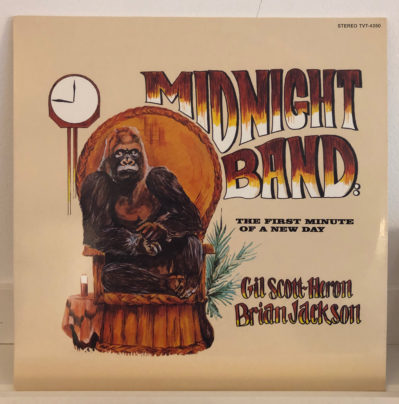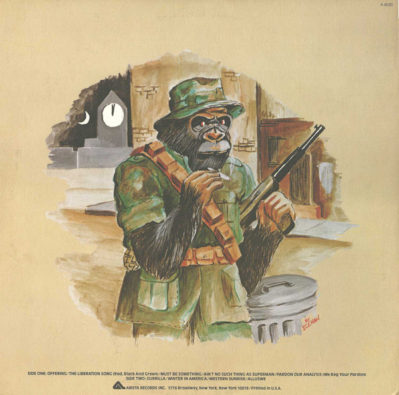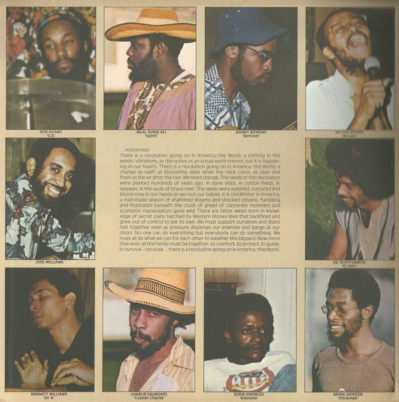In January 1975 in New York, NY, USA, a illustration of a gorilla in a rattan chair made by Iceman, was published on the cover of the album The First Minute of a New Day by American Gil Scott-Heron and Brian Jackson, The Midnight Band.
The First Minute of a New Day is an album by American jazz vocalist Gil Scott-Heron and keyboardist Brian Jackson, released in January 1975 on Arista Records.[…] The songs on The First Minute of a New Day, which feature themes ranging from spirituality (“Offering”) to revolution (“The Liberation Song”) and oppression (“Winter in America”), contain free jazz melodies by the Midnight Band and funk influences. “Winter in America” featured themes of struggle and had Scott-Heron singing of social, geographical and environmental oppression. The album’s only spoken word cut, also a live take, “Pardon Our Analysis” was a sequel to Winter in America’s “H20 Gate Blues” as a criticism of President Richard Nixon’s pardon, though this time the track did not feature a musical backing of any kind.
The artwork is designed by Iceman. This artist also responsible for the ‘gorilla in military costume’ on the back side of this album and the artwork for From South Africa To South Carolina (1975). Little is known about this artist (bio, other work or intentions), but based on the music and writing of Gil Scott-Heron we can reconstruct somewhat of the intentions.
The artwork that features the cover shows a gorilla sitting in a candid position in a peacock-chair. Next to the gorilla, on his right hand side, we can see a small table with a glass on it. On his left-hand side we see a plant. Perhaps a palm-tree. Behind this setting, a clock is displayed, which marks the time as either quarter to twelve or nine o’clock. I believe it is the first one. The significance of the clock is unclear to me.
Even though, I have not been able to find any sources that directly relate Gil Scott-Heron to the Black Panthers, his music is often seen as a soundtrack to the revolutionary nationalisme of the Black Panther Party and to the Black Power movement in general. (It is safe to say that on almost every so-called ‘black power’ mixtape you will find “The Revolution will not be Televised”). Scott-Heron is according to Ricky Vincent one of the most important voices in the black radicalism of the late sixties and early seventies (Vincent 2013, 108). Preceded by James Brown (Say it Loud, August 1968), Sly & the Family Stone (Don’t call me nigger, Whitey, 1969) and The Last Poets (When The Revolution Comes, 1970), “Gill Scott-Heron produced music with an angular, righteous voice of discontent that captured the imagination of a rebellious generation.” and “would go on to become one of the most important politically oriented black artists of his generation.” (Vincent 2013, 109).
On The First Minute of a New Day, Scott-Heron is talking about revolution, black identity and liberation (“The Liberation Song”), but he refrains from being specific. Perhaps the song/title that is the closes to Black Panther subject matter is “Guerilla”. In this song he is addressing issues as resistance, unity, liberation and black empowerment, but not in a specific American context. He is not talking about taking up arms in an urban guerrilla war.
“Said everybody knows, everybody knows, everybody knows brotherman’s a guerilla/Yeah, dig it/Never have to say “please,” never catch him on his knees now that he’s a guerilla” (Scott-Heron, 1975)
In the innersleeve of the record displays a text: “There is a revolution going on in America/TheWorld […] We must support ourselves and stand fast together even as pressures disperses our enemies and bangs at our doors. No one can do everything, but everybody can do something. […] Now more than overall the family must be together, to comfort, to protect, to guide, to survive — because… there is a revolution going on in America/theWorld.”
By being unspecific (or unanecdotical) and adding “the World” to statement above, Gil Scott-Heron expands his reach. He is talking about America, but at the same time he is talking about the black liberation and revolution, which were also happening on the African continent and on a global scale.
The question to answer is: Is this illustration referencing Huey P. Newton in a rattan chair? Furthermore, does the gorilla represent and honour the revolutionary warrior (the gorilla as a symbol of a brave, strong, stoic creature), American or global? Or is Iceman, here using the existing racial stereotype of the monkey to make a sarcastic critique on leadership and politics?




















